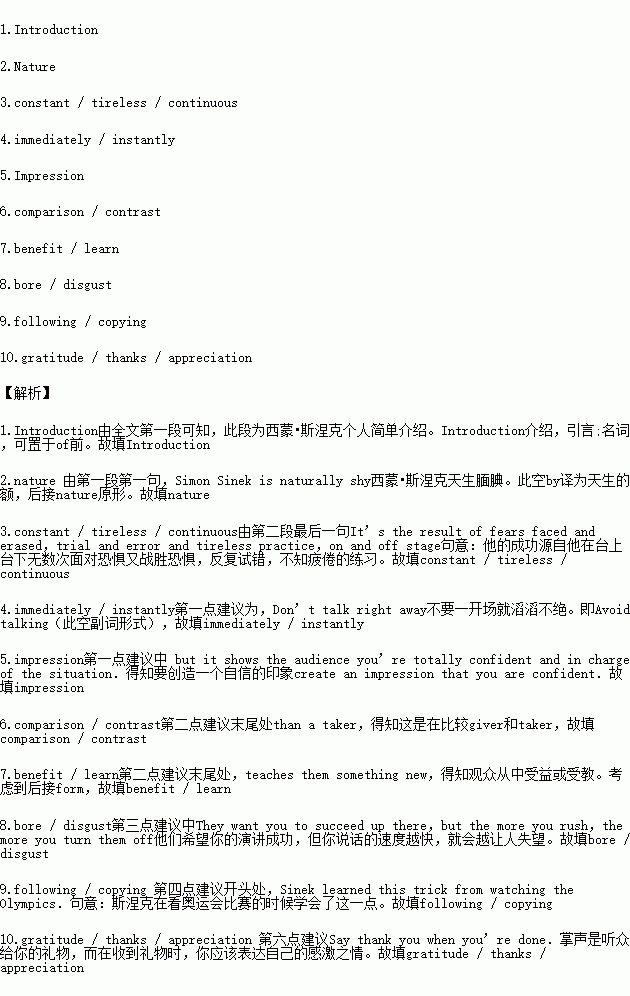题目内容
Simon Sinek is naturally shy and doesn’t like speaking to crowds.At parties,he says he hides alone in the corner or doesn’t even show up in the first place.He prefers the latter.Yet,with some 22 million video views under his belt,the optimistic ethnographer also happens to be the third most watched TED Talks presenter of all time.
Sinek’s unlikely success as both an inspirational speaker and a bestselling author isn’t just dumb luck.It’s the result of fears faced and erased,trial and error and tireless practice,on and off stage.Here are his secrets for delivering speeches that inspire,inform and entertain.
Don’t talk right away.
Sinek says you should never talk as you walk out on stage.“A lot of people start talking right away,and it’s out of nerves,” Sinek says.“That communicates a little bit of insecurity and fear.”
Instead,quietly walk out on stage.Then take a deep breath,find your place,wait a few seconds and begin.“I know it sounds long and tedious and it feels excruciatingly awkward when you do it,” Sinek says,“but it shows the audience you’re totally confident and in charge of the situation.”
Show up to give,not to take.
Often people give presentations to sell products or ideas,to get people to follow them on social media,buy their books or even just to like them.Sinek calls these kinds of speakers “takers,” and he says audiences can see through these people right away.And,when they do,they disengage.
“We are highly social animals,” says Sinek.“Even at a distance on stage,we can tell if you’re a giver or a taker,and people are more likely to trust a giver — a speaker that gives them value,that teaches them something new,that inspires them — than a taker.”
Speak unusually slowly.
When you get nervous,it’s not just your heart beat that quickens.Your words also tend to speed up.Luckily Sinek says audiences are more patient and forgiving than we know.
“They want you to succeed up there,but the more you rush,the more you turn them off,” he says.“If you just go quiet for a moment and take a long,deep breath,they’ll wait for you.It’s kind of amazing.”
Turn nervousness into excitement.
Sinek learned this trick from watching the Olympics.A few years ago he noticed that reporters interviewing Olympic athletes before and after competing were all asking the same question.“Were you nervous?” And all of the athletes gave the same answer: “No,I was exciteD. ” These competitors were taking the body’s signs of nervousness—clammy hands,pounding heart and tense nerves—and reinterpreting them as side effects of excitement and exhilaration.
When you’re up on stage you will likely go through the same thing.That’s when Sinek says you should say to yourself out loud,“I’m not nervous,I’m excited!”
Say thank you when you’re done.
Applause is a gift,and when you receive a gift,it’s only right to express how grateful you are for it.This is why Sinek always closes out his presentations with these two simple yet powerful words: thank you.
“They gave you their time,and they’re giving you their applause.” Says Sinek.“That’s a gift,and you have to be grateful.”
Passage outline | Supporting details |
1.to Simon Sinek | He is by 2.shy and dislikes making speeches in public. Through his 3.effort, he enjoys great success in giving speeches |
Tips on delivering speeches | Avoid talking 4.for it indicates you’re nervous. Keep calm and wait a few seconds before talking, which will create an 5.that you are confident. |
Try to be a giver rather than a taker because in 6.with a taker, a giver can get more popular and accepted. Teach audience something new that they can 7.from. | |
Speak a bit slowly just to help you stay calm Never speed up while speaking in case you 8.the audience. | |
Switch nervousness to excitement by 9.the example of Olympic athletes. | |
Express your 10.to the audience for their time and applause to conclude your speech. |
 开心蛙口算题卡系列答案
开心蛙口算题卡系列答案
| NEWRI Environmental Master of Science NEWRI: Nanyang Environment & Water Research Institute Be a leader in environmental science and engineering through the NEMS programme |
NEWRI Environmental Master of Science(NEMS) is a primary graduate education and research programme conducted by Nanyang Technological University’s (NTU’s) NEWRI, with summer attachment at Stanford University. It aims to train engineers and scientists to meet the increasing environmental challenges for Asia and the wider region. | NEWRI-Nanyang Environment & Water Research Institute NEWRI is enabling Singapore to be a global center of environmental science and technology in providing technological solutions to the world. It is committed to environmental and water technologies through its ecosystem of education, research and developmental activities. NEWRI is trying its best to pull together NTU’s water and environment-related centers and institutes, gathering one another’s strengths for the benefit of industry and society. |
Master of Science Applications ●Applications open now and close on 30 May 2012 for Singapore applicants. ●Graduates having relevant engineering or science background, including final-year students, are invited to apply. ●Applicants are required to have a certificate of GRE. Further information and application materials are available at the Website: www.ntu.edu.sg/cee/program/postgrad.asp | Highlights of Programme: ★Students spend a full summer term at Stanford taking regular courses and continue with the rest of their academic programme at NTU. ★It is a 12-month full-time course in environmental science & engineering. ★Students under NEMS will have opportunities to do research projects under NEWRI as well as to continue for the Doctor’s degree. ★Graduating students receive the NTU degree and a certificate from Stanford for their summer attachment. |
Scholarship for tuition grants and living expenses at both Stanford and NTU are available | |
Enquiry contact: Ms Christian Soh Tel:(65) 6861 0507 Fax:(65) 68614606 Email: nems@ntu. edu. sg Information on other graduate programmes available at: www.ntu.edu.sg/cee/program/postgrad.asp |
1.Students admitted to the NEMS Programme __________.
A. will first have regular courses at Stanford
B. needn’t be released from their regular jobs
C. are required to obtain a Doctor’s degree
D. can receive degrees of both NTU and Stanford
2.What’s the main purpose of the NEMS programme?
A. To offer scholarship for tuition grants and living expenses.
B. To strengthen the cooperation between NTU and Stanford.
C. To cultivate experts on environmental science and engineering.
D. To introduce Nanyang Environment&Water Research Institute.
3.Which of the following is TRUE according to the passage?
A. 30 May 2012 is the deadline for NEMS application.
B. Applicants for NEMS should have relevant work experience.
C. Other centers and institutes for environmental and water technologies also exist in NTU.
D. Singapore is the global center of environmental science and technology.


 NEMS
NEMS